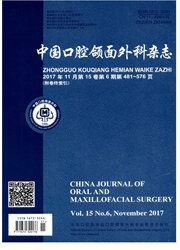

 中文摘要:
中文摘要:
目的:观察局部注射神经生长因子(NGF)对下颌骨牵张成骨中新生骨痂钙化的作用。方法:对20只新西兰白兔实施牵张速率为1mm/d的双侧下颌骨牵张成骨。从牵张结束时开始,每只兔的一侧下颌骨新生骨区接受人NGFβ溶液注射(40μg,次,2次),另一侧注射生理盐水作为对照。在固定期第14和28d,新生骨痂经X线侧位片和外径测量后,进行骨沉积速度和钙化面积比定量分析。应用SPSS10.0软件包进行配对t检验,分析NGF处理侧与对照侧之间上述2个钙化指标的差异。结果:与对照侧比较,NGF处理侧的钙化面积比和固定期第1~11d内的骨沉积速度均显著提高(P〈0.05),骨痂钙化得到了促进。结论:局部注射人NGFβ溶液能促进兔下颌骨牵张成骨中新生骨痂的钙化,为临床上解决固定期过长的问题提供了一种新的思路。
 英文摘要:
英文摘要:
PURPOSE: To evaluate the ability of locally applied NGF to enhance callus mineralization in a rabbit model of mandibular distraction osteogenesis. METHODS: 20 New Zealand white rabbits underwent bilateral distraction osteogenesis with a rate of 1 mm/day. 0.04 mg hNGF betta in buffer were injected into the callus two times after the end of distraction. The contralateral side received injections of normal saline. The rabbits were sacrificed at consolidation time of 14 and 28 days. After lateral X-rays and dimension measurements, regenerate callus was subjected to histomorphometric analysis of mineral apposition rate and mineralized bone percentage. A paired t test was performed using SPSS 10.0 software package. RESULTS: The results showed that mineralized bone percentage and mineral apposition rate of the 1st-11th day were significantly higher in the hNGF betta side (P〈0.05). CONCLUSION: Locally applied hNGF betta can accelerate callus maturation in a rabbit model and may be an option to shorten the consolidation period in mandibular distraction osteogenesis.
 同期刊论文项目
同期刊论文项目
 同项目期刊论文
同项目期刊论文
 Locally applied nerve growth factor enhances bone consolidation in a rabbit model of mandibular dist
Locally applied nerve growth factor enhances bone consolidation in a rabbit model of mandibular dist Nerve Growth Factor delivery via gels enhances bone consilidation in mandibular distraction osteogen
Nerve Growth Factor delivery via gels enhances bone consilidation in mandibular distraction osteogen 期刊信息
期刊信息
